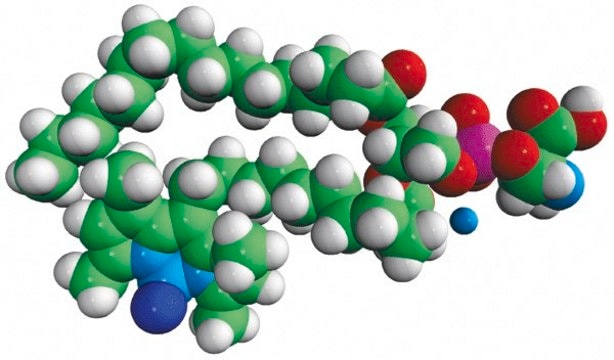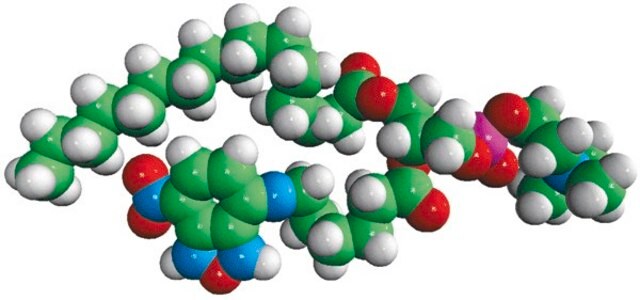810192C
Avanti
16:0-06:0 NBD PS
Avanti Research™ - A Croda Brand 810192C
동의어(들):
1-palmitoyl-2-{6-[(7-nitro-2-1,3-benzoxadiazol-4-yl)amino]hexanoyl}-sn-glycero-3-phosphoserine (ammonium salt)
로그인조직 및 계약 가격 보기
모든 사진(2)
About This Item
실험식(Hill 표기법):
C34H59N6O13P
CAS Number:
Molecular Weight:
790.84
UNSPSC 코드:
12352211
NACRES:
NA.25
추천 제품
분석
>99% (TLC)
형태
liquid
포장
pkg of 1 × 1 mL (810192C-1mg)
제조업체/상표
Avanti Research™ - A Croda Brand 810192C
농도
1 mg/mL (810192C-1mg)
배송 상태
dry ice
저장 온도
−20°C
일반 설명
Phosphatidylserine (PS) is a minor phospholipid present in the membranes of prokaryotic and eukaryotic cells. It comprises 2-10% of total phospholipids, enriched in brain. NBD PS is labelled at the headgroup of PS with 7-nitrobenz-2-oxa-1,3-diazol-4-yl (NBD).
애플리케이션
16:0-06:0 NBD PS or 1-palmitoyl-2-{6-[(7-nitro-2-1,3-benzoxadiazol-4-yl)amino]hexanoyl}-sn-glycero-3-phosphoserine (ammonium salt) is suitable to measure the enzyme specificity of lipoteichoic acid (LTA) synthase (LtaS) and in liposomes to determine the role of phospholipid scramblase 1 (PLSCR1) in phospholipid scrambling.
생화학적/생리학적 작용
Phosphatidylserine (PS) contributes to the clearance of apoptotic cells. It is involved in maintaining the nerve cell membrane and myelin sheath. It is associated with cognitive disability in Alzheimer′s disease.
포장
5 mL Amber Glass Screw Cap Vial (810192C-1mg)
법적 정보
Avanti Research is a trademark of Avanti Polar Lipids, LLC
신호어
Danger
Hazard Classifications
Acute Tox. 3 Inhalation - Acute Tox. 4 Oral - Aquatic Chronic 3 - Carc. 2 - Eye Irrit. 2 - Repr. 2 - Skin Irrit. 2 - STOT RE 1 - STOT SE 3
표적 기관
Central nervous system, Liver,Kidney
WGK
WGK 3
시험 성적서(COA)
제품의 로트/배치 번호를 입력하여 시험 성적서(COA)을 검색하십시오. 로트 및 배치 번호는 제품 라벨에 있는 ‘로트’ 또는 ‘배치’라는 용어 뒤에서 찾을 수 있습니다.
Nobuto Arashiki et al.
Biochemistry, 55(25), 3504-3513 (2016-06-09)
An asymmetric distribution of phospholipids in the membrane bilayer is inseparable from physiological functions, including shape preservation and survival of erythrocytes, and by implication other cells. Aminophospholipids, notably phosphatidylserine (PS), are confined to the inner leaflet of the erythrocyte membrane
Jean E Vance et al.
Progress in lipid research, 44(4), 207-234 (2005-06-28)
Phosphatidylserine (PS) is a quantitatively minor membrane phospholipid that is synthesized by prokaryotic and eukaryotic cells. In this review we focus on genes and enzymes that are involved in PS biosynthesis in bacteria, yeast, plants and mammalian cells and discuss
Maria Mercedes Palomino et al.
Microbiology (Reading, England), 159(Pt 11), 2416-2426 (2013-09-10)
The probiotic Gram-positive bacterium Lactobacillus casei BL23 is naturally confronted with salt-stress habitats. It has been previously reported that growth in high-salt medium, containing 0.8 M NaCl, leads to modifications in the cell envelope of this bacterium. In this study
Michael J Glade et al.
Nutrition (Burbank, Los Angeles County, Calif.), 31(6), 781-786 (2015-05-03)
The aim of this study was to assess the roles and importance of phosphatidylserine (PS), an endogenous phospholipid and dietary nutrient, in human brain biochemistry, physiology, and function. A scientific literature search was conducted on MEDLINE for relevant articles regarding
Maria Karatsa-Dodgson et al.
Journal of bacteriology, 192(20), 5341-5349 (2010-08-17)
Lipoteichoic acid (LTA) is an important cell wall component of Gram-positive bacteria. The key enzyme responsible for polyglycerolphosphate lipoteichoic acid synthesis in the Gram-positive pathogen Staphylococcus aureus is the membrane-embedded lipoteichoic acid synthase enzyme, LtaS. It is presumed that LtaS
자사의 과학자팀은 생명 과학, 재료 과학, 화학 합성, 크로마토그래피, 분석 및 기타 많은 영역을 포함한 모든 과학 분야에 경험이 있습니다..
고객지원팀으로 연락바랍니다.









